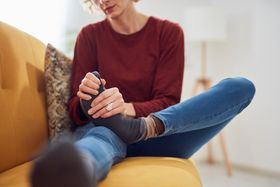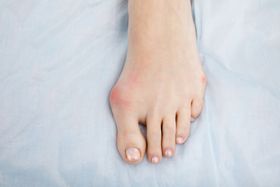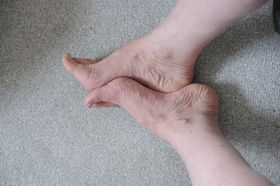Best Sesamoiditis Treatments: Exercises, Orthotics, and More
Updated February 17, 2023

Sesamoid bones are small-sized bones embedded in muscles or tendons. They serve to reinforce the joints and reduce the strain on the tendons. There are three main types of sesamoid injuries:
- Sesamoiditis
- Turf toes
- Sesamoid bone fracture
Sesamoiditis is an overuse injury that results in chronic inflammation of the sesamoid bones and tendons around them.
Of the sesamoid bones in the body, the tibial and fibula sesamoids of the great toe are often the most affected. Consequently, the term sesamoiditis is often used exclusively to refer to the inflammation of the sesamoid bones in the feet.
The most common cause of sesamoiditis is overuse. Sports like running and basketball and activities like dancing that place a lot of pressure on the balls of the feet are all common causes of sesamoiditis. You may also have a sesamoid bone fracture; although, this is less common.
Symptoms of Sesamoiditis
When sesamoiditis occurs, you can expect to experience:
- Pain under the ball of the foot that is gradual and worsens over time.
- Swelling or bruising.
- Difficulty moving the big toe and walking.
This is why sesamoiditis and gout are sometimes confused, but they are very different.
How Sesamoiditis Is Diagnosed
There are two types of sesamoiditis; tibial and lateral sesamoiditis.
Often, the symptoms of pain, swelling, and movement difficulty are enough to determine whether it is just inflammation or otherwise. Sometimes though, it isn’t just that there is a chronic injury of the sesamoid bone. It can be that there is a break of the sesamoid bones.
When the sesamoid bone is fractured, walking causes a deep ache in the ball of the foot behind the big toe. You may also notice redness and swelling.
In any case, to diagnose sesamoiditis, your doctor will conduct a physical examination of the foot to determine areas of tenderness. The doctor will also assess the range of motion of your feet in different directions while assessing the intensity and nature of pain.
Most times, this is enough to determine if there is sesamoiditis. To confirm the diagnosis, the doctor may order an X-ray, a bone scan, an ultrasound, or MRI to help in the diagnosis of the condition.
Sesamoid Pain Treatment
The mainstay of management with sesamoiditis is pain relief. You can achieve this through several home remedies, exercises, medications, physical therapy, orthotics, and surgery.
Home-Remedies for Sesamoiditis
Home sesamoiditis treatment normally takes around six weeks to reduce discomfort. Your sesamoiditis may usually be treated at home by the following methods:
- Rest your foot by reducing or eliminating activities that can cause pain, such as dancing and running.
- To reduce swelling, apply ice for 10 minutes every three hours.
- If you have foot pain, try taking ibuprofen (Advil) or aspirin (Bayer).
- Cortisone injections can also be effective anti-inflammatories and pain-relievers.
Physical Therapy for Sesamoiditis Bone Pain
The physical therapist will work to relieve your pain and reduce the swelling. Possible treatments may include ultrasound, moist heat, exercises, and massage.
The physiotherapist may also use padding, strapping, or taping to reduce the movement of the big toes and protect the area while it heals. Physiotherapy intervention may also occur in the post-operative phase of recovery.
Treatment Exercises for Sesamoiditis
Exercises are central to the non-surgical management of sesamoiditis. These exercises can be the range of motion, stretching, or strengthening exercises. Once the pain and discomfort are down, you can try the following exercises;
- Big toe curls Wrap a low-tension resistance band around your big toe for this workout that may help restore movement to the big toe. Then, against resistance, softly bend and straighten this toe. Start with smaller motions and then gradually increase the curls. Repeat 10 to 20 times daily.
- Toe crunches These can help with mobility and strengthening. Place a towel directly beside your affected foot while sitting in a chair. Using only the toes of the affected foot, pick up the towel. Release the towel and repeat the exercise more times daily or as instructed.
- Toe stretches These might help you regain mobility. While seated comfortably with the heel of the foot rested, fan out the toes of the affected leg as much as possible. Repeat the motion as many times as possible.
- Foot raises This can help in strengthening the foot. From an erect standing position, rise to your toes, lifting your heels off the ground. Hold the position for a few seconds before lowering your heels. Repeat 10 to 15 times daily or as suggested by your doctor.
Best Shoes and Orthotics for Sesamoiditis
Both sesamoiditis orthotics and shoes serve to reduce the pressure on the feet and thus promote healing.
The ideal shoe for sesamoiditis will ease any excessive load or impact on the sesamoid bones. Avoid shoes that have high heels or pointed toes as they increase the pressure on the forefoot and can worsen the condition.
Sesamoiditis orthotics are designed to ease discomfort and improve healing by reducing the stress on the affected sesamoids and shifting weight onto the arch or the metatarsal heads. The best insoles for sesamoiditis are made from certain materials like gel and foam so they provide shock absorption, cushioning, and support to the feet, and may be used for the duration of problems. Since this condition can heal, it's unlikely you'll need to wear orthotics forever. If you can't afford the cost of custom orthotics, consider getting them covered by insurance.
» Unsure which orthotics will suit you best? Consider trying running custom orthotics for effective shock absorption and pain reduction
The Fastest Way to Cure Sesamoiditis
None of the aforementioned treatments are necessarily faster than the others. It is best to include multiple treatments at the same time as that may speed up recovery more than individual treatment options.
Sesamoiditis Recovery Time
The speed of recovery from sesamoiditis depends on the severity of the condition, its cause, and the onset of intervention. Generally, mild cases of sesamoiditis will resolve in a few days with rest, medication, ice, and activity modification, while more severe cases may take longer.
If problems persist, the doctor may prescribe a 4-6-week period of wearing a detachable, short leg brace that can help to alleviate discomfort and pressure.
Sesamoiditis Fracture Healing Time
Sesamoid fractures generally take between 4-8 weeks to heal. If the bone is broken but still in place, a special corrective shoe will be enough. Otherwise, surgery will be necessary to realign the broken bones.
When Is Surgery Necessary for Sesamoiditis?
When conservative sesamoiditis treatments fail for multiple weeks, or if your condition is severe and accompanied by swelling or discoloration, surgery may be necessary.
Sesamoiditis surgery, otherwise known as a sesamoidectomy, involves removing one of the sesamoid bones to relieve pain and eliminate the condition. Only one bone is removed, as any more than that may cause additional problems and lasting pain.
Tips for Prevention of Sesamoiditis
Since excess pressure is the leading cause of sesamoiditis, the best way to prevent sesamoiditis is to improve the support, stability, shock absorption, and cushioning of your feet as you perform your daily activities.
Wearing comfortable and proper-fitting shoes is a good way to do this. You may also wear a supportive insole to support the bottom of the feet and reduce the pressure on the sesamoid bones.
Overpronation can also predispose people to sesamoiditis. Therefore, gait reeducation can also help reduce the stress on the foot joints and, consequently, sesamoiditis. Gait reeducation will emphasize shorter strides and mid-foot strikes instead of using the forefoot, thus reducing the pressure experienced by your sesamoids.
» Still unsure if orthotics are the way to go? Peruse a variety of custom orthotics to find a solution best suited for you








